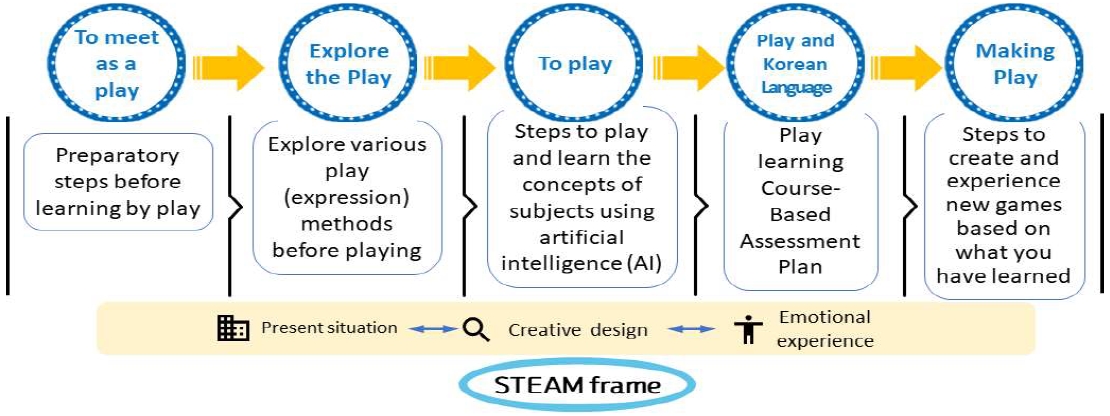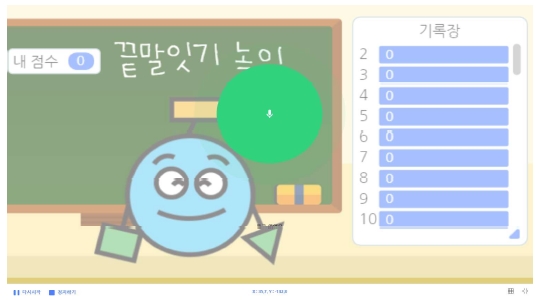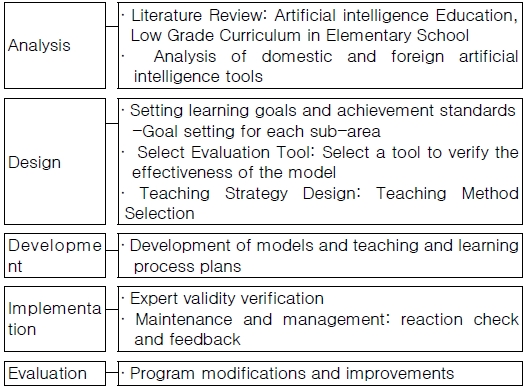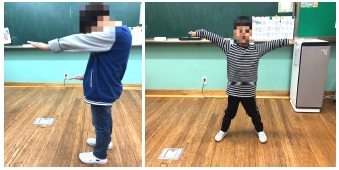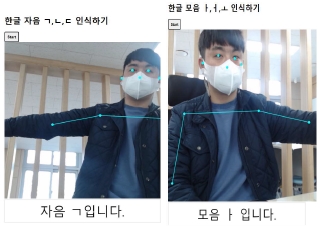
초등학교 저학년 대상 인공지능 도구 활용 STEAM 교육 프로그램 개발
Copyright ⓒ 2020 The Digital Contents Society
This is an Open Access article distributed under the terms of the Creative Commons Attribution Non-CommercialLicense(http://creativecommons.org/licenses/by-nc/3.0/) which permits unrestricted non-commercial use, distribution, and reproduction in any medium, provided the original work is properly cited.

초록
이 연구의 목적은 초등학교 저학년에서 활용 가능한 인공지능 도구를 활용한 교육 프로그램을 개발하는 것이다. 이를 위해 저학년에서 필수적으로 학습해야 할 한글교육, 기초수학 등의 내용을 동작 인식, 이미지 인식, 음성 인식, 얼굴 인식 등 인공지능 기술을 활용한 놀이로 체험할 수 있는 자료를 개발하였다. 개발한 프로그램의 내용 타당도를 검증하기 위해 전문가 15인에게 검증을 2차례 실시하여 타당도를 확보하고 자료를 수정·보완하여 최종 프로그램을 개발하였다. 향후 5종의 프로그램을 수업에 활용하고 효과성을 검증할 필요가 있으며, 여러 교과에서 인공지능 도구를 활용 가능한 다양한 자료가 개발하고자 한다.
Abstract
The purpose of this study is to develop educational programs utilizing artificial intelligence tools that can be used in elementary school grades. For this purpose, we have developed materials that can be experienced by playing using artificial intelligence technologies such as motion recognition, image recognition, speech recognition, facial recognition, etc., contents such as Hangul education and basic mathematics that must be learned in the lower grades. In order to verify the validity of the program developed, 15 experts were tested twice to secure validity and modify and supplement the data to develop the final programs. In the future, it is necessary to use five kinds of programs in class to verify its effectiveness, and to develop a variety of materials that can be used in various classes.
Keywords:
Artificial Intelligence, Artificial Intelligence Education, STEAM, Artificial Intelligence for Lower Grades in Elementary School, Learning using Artificial Intelligence Tools키워드:
인공지능, 인공지능 교육, 스팀, 초등 저학년을 위한 인공지능 교육, 인공지능 도구 활용 교육Ⅰ. 서 론
최근 미국, 일본, 독일 등 해외 각국에서 인공지능교육에 힘을 쏟고 있다[1]-[3]. 특히, 중국의 경우 유치원부터 인공지능교육을 실시하고 있으며, 총 33종 교재 보급하고 전면적으로 인공지능교육을 추진하고 있다[4]. 우리나라의 경우 현재 차세대 소프트웨어교육 교육과정 연구에 의하여 인공지능 융합영역을 추가하고, 교원 양성을 위해 교육대학원에 인공지능교육 관련 학과를 개설해 2020년부터 운영하고 있다[5][6]. 결국 나라마다 정책의 방향은 다르나 대부분의 선진국에서는 교육정책 중 인공지능교육을 우선으로 다루고 있다.
그러나, 우리나라의 경우 차세대 교육과정이 도입되더라도 초등학교 6학년에만 적용될 가능성이 높기에 6학년 교육과정과 연계할 수 있는 저학년 콘텐츠 개발이 필요한 실정이다. 더욱이 현재 소프트웨어교육 또는 인공지능교육과 관련한 교육과정이 없기 때문에 저학년 교육과정에 적용하기 위해서는 STEAM 관련 과목 통합교육이 필요하리라 사료된다.
한편 STEAM 관련 교육 프로그램은 다양한 분야에서 연구[7]-[9]되고 있으며 시·도교육청 또는 정부출연연구기관에 의해 개발되어 학교 현장에 보급되고 있다. 이중 대표적인 기관은 한국과학창의재단이 매년 운영하고 있는 STEAM 프로그램 개발 사업이다. 이 사업에 의해 우수한 프로그램이 개발되어 보급되고 있으나, 초등학교 저학년 수준에서 일반화하기에는 구성 내용이나 방법적으로 다소 어려움이 있는 실정이다. 또한 이중 인공지능 및 소프트웨어교육 프로그램의 경우 컴퓨터, 스마트패드, 교육용 로봇 등 다양한 도구를 활용한 교육 프로그램이 많은 편이다. 교구 및 교육용 로봇을 활용할 경우 동기유발 및 창의성 계발, STEAM의 준거 중 창의적 설계에 유용한 장점은 있으나, 교구 추가 구입이 필요하여 개발된 콘텐츠의 일반화에 걸림돌이 될 수 있다. 또한, 기기 조작이 서투른 초등학교 저학년 대상으로 활용하기 어렵다는 단점이 있다.
따라서, 이 연구에서는 인공지능교육의 연계성 확보 및 일반화 가능성 확보를 위해 유치원·초등학교 1∼2학년 단계에서 많은 차시를 차지하고 있으며, 담임교사들이 필수적으로 지도해야 하는 한글교육 및 기초수학 등을 주제로 삼았다. 그리고 학생들의 발달 단계와 일반화를 고려하여 학생들이 컴퓨터와 도구의 조작하는 것을 최소화할 수 있도록 기존 인공지능 교육 도구들을 분석하여 교수·학습을 설계하였다. 프로그램 개발 과정에서 전문가 집단에 의해 타당성 검증을 거치면서 교수학습 내용의 수정·보완을 하여 최종 5개 주제의 교사 및 학생용 교재를 개발하였다.
Ⅱ. 관련 연구
2-1 우리나라 2019 개정 누리과정의 구성 방향
초등학교 저학년 대상 학습 프로그램을 개발하기 2019년에 개정한 유치원 교육과정인 누리과정의 특징을 살펴보았다. 이번 누리과정은 ‘유아·놀이 중심’을 추구하는 교육과정으로 명시하고 있다. 구체적으로 살펴보면 내용 영역 구성은 유아의 경험과 밀접하게 관련성 있는 내용을 선정하여 신체운동·건강, 의사소통, 사회관계, 예술경험, 자연탐구로 구성하고, 유아교육의 목적, 목표를 달성하기 위해 놀이를 내용과 방법으로 적극적으로 활용해야 함을 명시히고 있다[10]. 따라서, 초등학교 1∼2학년 대상 교육 프로그램 설계에 놀이에 대한 접근의 필요성에 시사 하는바가 크다고 할 수 있다.
2-2 국내·외 인공지능교육 관련 연구
미국은 미국과학연구재단에서 국립인공지능연구센터 설립하고, 초·중·고 인공지능교육 관련 연구 과제를 전폭적으로 지원하고 있다. 미국의 인공지능교육 관련 대표적인 기관 및 사이트는 다음 표 1과 같다[11]. 특히, AI4K12의 인공지능의 5가지 빅아이디어는 국내의 연구자들에게 영향을 주었다. 5가지 빅아이디어는 ‘인식’, ‘표현과 추론’, ‘학습’, ‘자연스러운 상호작용’, ‘전사회적 영향력’으로 구성되어 있다. 이 연구에서는 5가지 빅아이디어 중 초등학교 저학년 학생의 발달단계에 직접적으로 체험을 통해 이해할 수 있는 개념을 중심으로 구성하였다.
한편, 중국은 2019년부터 유치원부터 AI교육을 시작하였으며[12]-[13], 이 연구에 해당하는 초등학교 1∼2학년 허난성에서 발행한 교과서의 목차 일부를 요약하면 표 2와 같다. 물론 목차로 교재의 내용을 모두 알수는 없지만, 대체적으로 교육용 로봇을 활용한 제작 중심의 활동, 즉 우리나라의 소프트웨어교육과 연계한 인공지능교육을 초등학교 저학년에서 전개되리라 예상된다. 이 외에도 말레이시아도 2020년부터 초등학교 4학년 교과과정에서 인공지능, 프로그래밍, 로봇학 내용이 포함된 설계 및 테크놀로지 과목을 편성하여 운영하고 있다[14]. 일본도 ‘AI 전략 2019’에 따르면 2020년부터 모든 초등학교와 중학교 과정에 프로그래밍 교육을 의무화하고 있다[15].
한편 이은경(2020)의 경우 국내·외 인공지능교육 교육과정을 분석하여 교육과정에서 다루고 있는 핵심주제, 적용 대상, 적용 시기, 연구 상황을 조사[16]하였다. 이 연구 결과를 토대로 살펴보면 앞서 살펴본 미국, 중국과 동일하게 EU역시 모든 연령대를 대상으로 도입하거나 할 예정이나, 우리나라의 경우 소프트웨어교육의 일부영역으로 도입 예정이어서 저학년을 위한 프로그램 개발 연구가 동시에 수행될 필요가 있다고 판단하였다.
Ⅲ. 연구 방법
3-1 연구의 과정 및 절차
연구의 과정 및 절차는 체제적 교수설계 모형인 ADDIE 모형의 단계에서 실행 단계를 제외한 분석-설계-개발-평가 단계로 연구를 수행하였으며, 각 단계별 내용은 표 3과 같다.
기존 인공지능교육 연구물 및 초등 저학년 교육과정 분석하여 저학년 대상으로 교육이 가능한 주제를 탐색하였다. 또한, 초등학교 저학년 발달단계에 부합하고 활용이 가능한 인공지능 도구를 탐색하였다. 특히 현재 인공지능교육과 관련된 교육과정은 없기 때문에 저학년 교육과정과 연계할 수 있는 다양한 STEAM 관련 융합 아이디어를 도출하고자 노력하였다.
분석 단계에서 다양하게 탐색한 아이디어를 중심으로 초등학교 교사로 소프트웨어교육에 전문성을 지니고 있는 교사들과 협의로 도출한 활동 주제와 인공지능 도구는 다음 표 4와 같다. 활동 주제는 개발한 프로그램의 일반화 가능성을 높이기 위해 초등 저학년에서 필수적인 내용인 한글교육, 도형교육, 자신의 신체 및 감정 이해를 선정하였으며, 이를 효율적으로 학습할 수 있도록 Teachable Machine, AutoDraw와 같은 기존 인공지능 도구를 활용하거나, 끝말잇기와 같이 적합한 것이 없을 경우 엔트리를 활용하여 음성으로 끝말잇기 게임을 할 수 있는 프로그램을 자체 개발하였다.
학습 단계의 큰 흐름은 초등 저학년 학생 발달단계에 적합한 놀이를 중심으로 놀이 만나기, 놀이 탐색하기, 놀이 하기, 놀이 만들기 단계로 구상하였다. 또한 학습 단계의 큰 흐름에서 STEAM교육의 준거인 상황제시, 창의적 설계, 감성적 체험을 교수·학습 과정에서 적합하게 투입하여 효율적인 학습이 이루어질 수 있도록 고려하였다. 이러한 내용을 도식으로 제시하면 그림 1과 같다.
2020년 9월에 완성된 1차 놀이 중심 인공지능 교구 활용 한글교육 프로그램의 타당도 평가를 위하여 교육 경력이 15년 이상이고, 소프트웨어교육 관련 석사 이상의 학위를 소지하고 있으며, 관련 논문을 게재한 실적이 있는 전문가 15명을 선정하여 검증을 받았다. 타당도 검증을 위한 검사도구는 김진옥 등(2020)의 연구에서 사용한 도구[12]를 이 연구의 목적에 맞게 수정하여 전문가 집단에게 타당도 검증을 거친 후 사용하였다.
조사 문항은 총 12문항으로 리커르트(Likert) 5단계 척도의 선택형 11문항과 수정 및 보완 사항을 자유 서술하는 개방형 1문항으로 구성되었으며, 이를 평가 영역, 평가 유형, 문항 번호 등으로 제시하면 표 5와 같다.
평가 단계에서는 전문가 타당성 평가에 의해 도출된 양적분석 자료와 자유서술식 유형으로 기술된 수정·보완 의견을 토대로 프로그램을 수정·보완하였다.
3-2 타당성 검증 방법
타당성 평가 결과 분석을 위해서 Lawshe(1975)의 내용타당도 비율(Content Validity Ratio: CVR) 계산 공식[17]을 활용하였다. 타당도 비율은 특정 문항이 내용을 잘 또는 적절하게 측정한다고 응답한 비율을 선형적으로 변화시킨 값을 의미한다. 다음 표 6은 Lawshe의 내용타당도 비율을 구하는 공식을 표현한 것이며, 이 연구에서는 리커르트 척도의 ‘대체로 그렇다’와 ‘매우 그렇다’에 해당하는 4점과 5점에 해당하는 응답자의 빈도수를 Ne로 간주하여 분석하였다. 타당도 검증의 기준은 기존 연구에서는 CVR값이 0.6미만이 경우 타당도가 낮다고 판단하였지만 이 연구에서는 좀 더 엄격하게 CVR값이 0.7미만인 경우 타당도가 낮다고 판단하였다.
Ⅳ. 연구 결과
4-1 전문가 평가 결과
이 연구에서 개발한 놀이 중심 인공지능 도구 활용 교육 프로그램에 대한 타당성 검사 결과를 M, SD, CVR값으로 분석한 결과를 살펴보면 표 7과 같으며, 전문가들의 자유기술식 수정·보완 의견은 표 8과 같다. 이중 자유기술식 수정·보완 의견으로는 아이디어가 참신하다 등의 긍정적인 의견이 다수 있었으나, 이 논문에는 실제로 수정·보완의 의견을 제시한 내용만 발췌하여 정리하였다. 선택형 검증 결과 중 2개의 세부 평가기준을 제외한 9개의 세부 평가기준에서는 CVR값이 0.7이상으로 매우 타당하다는 결과를 얻었다. 다만 STEAM 교육에 적합 정도와 학생 교재 난이도의 적절성의 경우 CVR값이 0.6으로 비교적 타당한 결과이지만, 이 연구에서 설정한 기준인 0.7보다는 낮게 나와 타당도가 미흡하다는 결과를 얻을 수 있었다. 특히 STEAM 교육에 대한 적합한 정도에 대한 낮은 타당도의 결과에는 자율기술식 수정·보완 의견 중 ‘초등학교 저학년에 적용하다보니 이 연구에서 활용한 STEAM 준거 중 창의적 설계의 기회를 제공하기에는 부족한 것으로 판단됨’ 에서 찾을 수 있었다. 또한, 학생 교재 난이도의 적절성이 비교적 낮게 나온 사유도 전문가의 의견 중 ‘학생 활동 시간을 충분히 확보해줄 필요가 있음’, ‘초등학교 1,2학년에게는 활동이 조금 많은 편임’ 등에서 찾을 수 있었다. 따라서 타당성 검증 결과 중 낮게 나온 원인을 자유기술식 의견에서 도출하여 프로그램을 수정·보완 하였다. 마지막으로 인공지능 관련된 자유기술식 의견이었던 ‘인공지능의 활용뿐만 아니라 인공지능에 대한 학생 수준의 이해가 제시되면 좋겠음’이라는 의견도 적극 반영하여 초등학교 1∼2학년 수준에서 이해 할 수 있는 수준으로 인공지능을 학습시키는 내용을 교사 중심으로 시연할 수 있도록 추가하여 수정·보완 하였다. 수정·보완 후 전문가 집단에게 수정대비표와 수정된 프로그램을 제공한 후 타당도가 낮게 평가된 2개의 평가기준에 대한 2차 검증을 실시하였으며, 표 9와 같이 두 개 평가기준 모두 매우 타당성이 있다는 결과를 얻었다.
4-2 놀이 중심 인공지능 도구 활용 초등 저학년 프로그램 개발 결과
초등학교 1학년 대상 프로그램은 이미지인식 놀이를 통한 한글교육과 머신러닝 놀이를 통한 도형교육이며 각 프로그램의 차시별 활동 내용을 제시하면 표 10, 표 11과 같다.
초등학교 2학년 대상 프로그램에는 음성인식 놀이를 통한 우리말교육, 이미지인식 놀이를 통한 우리 몸 알기, 얼굴인식 놀이를 통한 나의 감정 표현하기로 구성되어 있으며, 각 프로그램의 차시별 활동 내용을 제시하면 표 12, 표 13, 표 14와 같다.
개발한 5종의 프로그램을 지면상 제시하기는 어렵기 때문에 1학년용 ‘이미지인식 놀이를 통한 한글교육’에서 1차시 내용인 ‘동작 인식놀이를 통해 한글의 '자음', '모음'을 익혀요’ 의 교수·학습과정안을 제시하였으며 그 개요와 내용은 표 15, 표 16과 같다. 또한, 2학년용 프로그램 중 ‘음성인식 놀이를 통한 우리말 교육’ 프로그램에서 5∼6차시 내용인 인공지능과 끝말잇기 게임을 할 수 있도록 엔트리를 활용하여 제작한 게임의 화면을 제시하면 그림 2와 같다.
참고적으로 이 연구에서 개발한 끝말잇기 게임 주소는 ‘http://gg.gg/endw01’ 이다.
Ⅴ. 결 론
최근 교육계에서는 인공지능 교육에 대한 관심이 뜨겁다. 그러나, 현재까지 교육과정 연구 현황으로 보았을 때, 초등학교에는 6학년 실과교과서에 소프트웨어교육 단원에 일부 포함될 예정이어서 우려되는 바가 크다. 그 이유는 초등학교 다른 학년에 해당하는 교육과정이 없어서 연계성있는 교육이 이루어질 수 없기 때문이다.
따라서 이 연구에서는 향후 6학년 실과 교육과정에 포함될 가능성이 높은 인공지능 내용 영역을 초등학교 1∼2학년 학생들도 연계성 있게 체험할 수 있도록 구성한 프로그램을 개발하고자 하였다. 이 연구의 결과는 다음과 같다.
첫째, 인공지능 도구를 활용하고 놀이를 통해 직접적으로 체험할 수 있는 초등학교 1∼2학년용 프로그램을 개발하였다. 프로그램은 1학년 2종, 2학년 3종으로 총 5종을 개발하였다. 내용은 일반화 가능성을 높이기 위해 초등학교 저학년에서 필수적인 한글교육, 기초수학 등을 인공지능을 활용하여 교수·학습할 수 있도록 구성하였다.
둘째, 개발된 프로그램의 타당도를 검증하기 위해 전문가 집단을 대상으로 수업 목표의 적합성 3개, 자료의 적절성 4개, 자료의 적용 가능성 4개 총 11개의 평가기준 중 ‘STEAM 교육에 적합 정도’, ‘교재 난이도의 적절성 정도’를 2개의 평가기준을 제외한 9개의 평가기준의 타당도가 확보되었다. 자유기술식 수정·보완 의견을 바탕으로 프로그램을 수정·보완한 후 최종 프로그램을 완성하였다. 이후 2차 타당도 검증을 실시하여 2개의 평가기준에서도 타당성을 확보할 수 있었다.
연구 결과를 바탕으로 제언을 제시하면 다음과 같다.
첫째, 현재 교육과정 상 존재하지 않은 인공지능 관련 내용을 저학년 필수 내용인 한글교육, 기초수학 등의 내용에 접목하여 프로그램을 개발하고 내적 타당화 과정으로 현장 적용 가능성을 탐색하였지만, 향후 후속 연구로 수업에 투입하여 효과성 검증을 거치는 것이 필요하다.
둘째, 이 연구에 의해서 한글교육, 기초수학 등의 학습 내용을 인공지능 도구를 접목하여 효율적으로 수업할 수 있는 자료를 개발하였다. 향후 초등학교의 여러 교과에서 인공지능 도구를 활용할 수 있는 다양한 자료 개발이 후속 연구로 필요하다.
Acknowledgments
이 논문은 2020년도 교육부의 재원으로 한국과학창의재단의 지원을 받아 수행된 성과물임
References
- S. H. Kim, S. H. Kim, H. C. Kim, “Analysis of International Educational Trends and Learning Tools for Artificial Intelligence Education,” in Proceeding of The Korean Association of Computer Education, Vol. 23, No. 2, pp. 25-28, Aug, 2019.
- H. S. Jo, “AI education and R&D in the Netherlands,” Journal of Mutimedia Information System, Vol. 23, No. 1, pp. 34-43, April, 2020.
- E. K. Lee, “A Comparative Analysis of Contents Related to Artificial Intelligence in National and International K-12 Curriculum,” The Journal of Korean association of computer education, vol. 23, no. 1, pp. 37-44, 2020.
-
K. S. Kim, “An Artificial Intelligence Education Program Development and Application for Elementary Teachers,” Journal of The Korean Association of Information Education, Vol. 23, No. 6, pp. 629-637, December, 2019.
[https://doi.org/10.14352/jkaie.2019.23.6.629]

- C. H. Lee, D. M. kim, “Learning Elements of Artificial Intelligence Based on AI Element Technologies and Domestic and Foreign AI Curriculum,” Korean Association of Artificial Intelligence Education Transactions, Vo1. 1, No. 3, pp. 21-30, 2020
-
T. R. Kim, S. G. Han, “A Study on Elementary and Secondary Teachers' Perceptions on AI Education,” The Journal of Education, Vol. 40, No. 3, pp. 181~204, 2020.
[https://doi.org/10.25020/je.2020.40.3.181]

- B. R. Cho, J. M. Lee, “Effects of STEAM Education on Elementary School Student’s Creativity and Learning Flow,” Journal of Learner-Centered Curriculum and Instruction, Vol. 14, No. 9, pp. 87-105, 2014.
-
H. W. Kim, “Trends Analysis of Early Childhood STEAM Education Research in Korea,” Journal of Learner-Centered Curriculum and Instruction, Vol. 20, No. 5, pp. 1211-1234, 2020.
[https://doi.org/10.22251/jlcci.2020.20.5.1211]

-
E. J. Hwang, K. H. Han, “An analysis of the feasibility of applying STEAM in the education of applied music,” Culture and Convergence, Vol. 42, No. 1, pp. 43-61, January. 2020.
[https://doi.org/10.33645/cnc.2020.01.42.1.43]

- Ministry of Education, Revised Early Childhood Education Course. Ministry of Education, 2019.
- H. S. Kim, S. J. Jun, S. Y. Choi, S. A. Kim, “Development and Application of Education Program on Understanding Artificial Intelligence and Social Impact,” The Journal of Korean association of computer education, vol. 23, no. 2, pp. 21-29. 2020.
- JoongAng Libo. China publishes world's first AI textbook [Internet]. Available: https://news.joins.com/article/22613671, .
-
J. O. kim, S. J. Kim, S. S. Jo, G. R. Park, “Development of Learning Materials for Maker and Design Education with Coding Activity,” The Journal of Korean Practical Arts Education,Vol. 26, No. 1, pp. 105-124, 2020.
[https://doi.org/10.29113/skpaer.2020.26.1.007]

- Malaysia’s Ministry of Education to introduce AI, robotics and computer programming in school[Internet]. Available: https://opengovasia.com/malaysias-ministry-of-education-to-introduce-ai-robotics-and-computer-programming-in-school, .
- AI strategy 2019. [Internet]. Available: https://www.kantei.go.jp/jp/singi/tougou-innovation/pdf/aisenryaku2019.pdf, .
- E. K. Lee, “A Comparative Analysis of Contents Related to Artificial Intelligence in National and International K-12 Curriculum,” The Journal of Korean association of computer education, Vol. 23, No. 1, 37-44, 2020.
-
Lawshe, C. H. A quantitative approach to content validity. Personnel Psychology, Vol. 28, No. 4, pp. 563-575, 1975.
[https://doi.org/10.1111/j.1744-6570.1975.tb01393.x]

저자소개

2002년 : 공주교육대학교 컴퓨터교육과 (교육학석사)
2010년 : 한국교원대학교 컴퓨터교육과 (교육학박사)
2018년~현 재: 충남SW교육체험센터 교육연구사
※관심분야:컴퓨터교육, 소프트웨어교육, 인공지능교육

